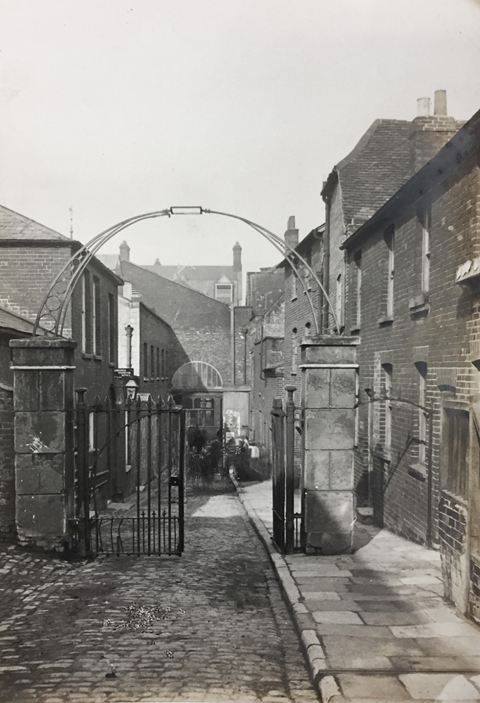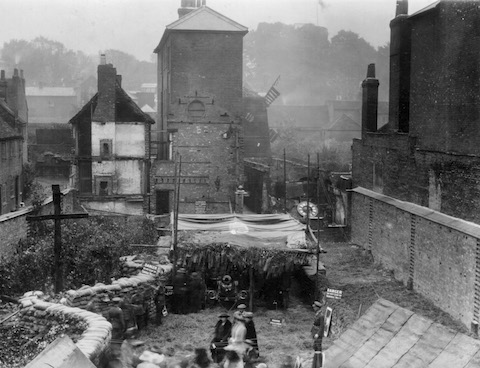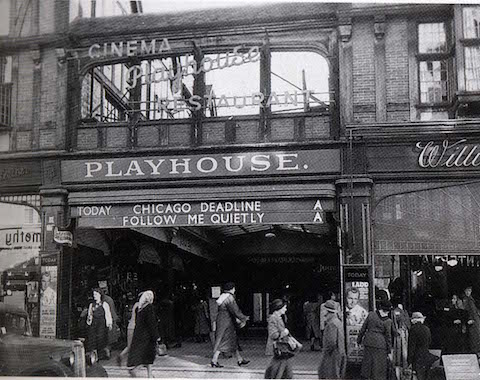 Abraham Lincoln
If given the truth, the people can be depended upon to meet any national crisis...
Abraham Lincoln
If given the truth, the people can be depended upon to meet any national crisis...
 Guildford news...
for Guildford people, brought to you by Guildford reporters - Guildford's own news service
Guildford news...
for Guildford people, brought to you by Guildford reporters - Guildford's own news service
Notice: Exhibition at Guildford Museum: Tunsgate – A Century Of Change
Published on: 1 May, 2018
Updated on: 1 May, 2018
March 2018 saw the launch of the latest incarnation of Tunsgate in central Guildford, with the opening of Tunsgate Quarter.
The Friends of Guildford Museum, working alongside staff from the museum in Quarry Street, are taking this moment to reflect on the last 100 years of history in this area. The display Tunsgate – A Century of Change – looks at this lively area in the heart of Guildford during the period 1918 to 2018.
The exhibition runs until Saturday, June 16 and entry is free.
In 1918 Tunsgate was a narrow, dark, mostly residential street next to the fire damaged remains of a large draper’s store. For a brief while the derelict area was used to recreate a scene from the Western Front called Flanders by Moonlight.
Following the First World War the area was transformed into ‘the place to be’ with the building of the Playhouse shopping arcade and cinema.

A view looking down Tunsgate towards the High Street as it once was.
Tunsgate itself was widened and opened up and many small businesses and shops moved in, such as Jeffery’s motor cycles and the London Camera Exchange which is still there today.
Boxer’s coffee bar was a popular haunt with young people in the 1950s and 60s and visitors can read about people’s memories – or perhaps reminisce themselves.
Redevelopment in the area from the 1970s, including the building of the more recent shopping centre, Tunsgate Square, led to archaeologists discovering many historic objects. These revealed the history of the area in earlier times, particular during the 17th century, when there was an inn on the site, called the Three Tuns.
Now the area is once again being given a new lease of life with the opening of Tunsgate Quarter.
The exhibition includes images tracing the development of the area, as well as depictions by local artist Henry Sage. It also includes items by arts and crafts artist John Selwyn Dunn. who had an outlet in Tunsgate.
John Selwyn Dunn worked in many different art forms. As well as painting in oils he painted china plates and jugs and he carved wood. He was a great follower and admirer of Willliam Morris and the pre-Raphaelites. The shop he had in Tunsgate was called Things of Beauty and Utility.
It is the second exhibition at Guildford Museum curated by community groups as part of a Your Stories, Your Museum project, supported using public funding from Arts Council England. The previous one that ran from November to January was Guildford at Work, staged by the members of the Joining In! Men’s Group that meets in Park Barn.
At noon on Friday, June 1, Hugh Anscombe, a member of the Friends of Guildford Museum, will give a free talk entitled Two Centuries and More of Change. The talk will look at the earlier history of this fascinating area of Guildford. Entry is free, but booking is essential.
To book the talk, and for further details, call the museum on 01483 444751 or email heritageservices@guildford.gov.uk.
The museum is on Quarry Street, Guildford GU1 3SX and is open Monday to Saturday, 11am to 5pm. Entry to the museum is free.

See Dragon story: GBC’s Explanation of Major Land Sale Notice Error ‘Borders on Arrogant’ Says Councillor




Recent Articles
- Letter: Does ‘Lest We Forget’ Mean Nothing?
- Police Appeal for Witnesses to Compton Collision
- What More Does the Solace Report Tell Us About the Housing Revenue Account Investigation?
- Guildford Has a New Mayor
- Notice: Exhibition – Ripley – World Famous Cycling Mecca
- Volunteer Organisers for the Poppy Appeal Urgently Needed
- ‘Damning’ Report Debated at Council Meeting – CEO Calls for Councillors to Come Together
- Surrey Children’s Services Improvement Recognised by Ofsted
- Independent Guildford Stationers Are ‘Top of the Shops’
- Birdwatcher’s Diary No.304


Search in Site
Media Gallery
Dragon Interview: Local Artist Leaves Her Mark At One of England’s Most Historic Buildings
January 21, 2023 / No Comment / Read MoreDragon Interview: Lib Dem Planning Chair: ‘Current Policy Doesn’t Work for Local People’
January 19, 2023 / No Comment / Read MoreA3 Tunnel in Guildford ‘Necessary’ for New Homes, Says Guildford’s MP
January 10, 2023 / No Comment / Read More‘Madness’ for London Road Scheme to Go Ahead Against ‘Huge Opposition’, Says SCC Leader
January 6, 2023 / No Comment / Read MoreCouncillor’s Son Starts Campaign for More Consultation on North Street Plan
December 30, 2022 / No Comment / Read MoreCounty Council Climbs Down Over London Road Works – Further ‘Engagement’ Period Announced
December 14, 2022 / No Comment / Read MoreDragon Interview: GBC Reaction to the Government’s Expected Decision to Relax Housing Targets
December 7, 2022 / No Comment / Read MoreHow Can Our Town Centre Businesses Recover? Watch the Shop Front Debate
May 18, 2020 / No Comment / Read More









Recent Comments